University Audit Test 1 Solution: Natural Supplements Finance
VerifiedAdded on 2020/05/11
|13
|2974
|429
Homework Assignment
AI Summary
This document presents a comprehensive solution to an audit test, focusing on the audit of Natural Supplements Nelson Limited (NSNL). The solution addresses acceptable audit risk, inherent and control risks, and their assessment, along with the analysis of financial statements using horizontal and vertical analysis. The assignment includes the calculation of various financial ratios, interpretation of the results, and identification of areas requiring special attention. Furthermore, it explains the concept of materiality, differentiating between performance, planning, and specific materiality levels, and provides calculations for planning and performance materiality. Part B of the solution outlines audit assertions and steps for inventory auditing, emphasizing prior planning, staff organization, and correct stock valuation. The assignment covers all aspects of the audit process, providing a complete and detailed understanding of the subject matter.
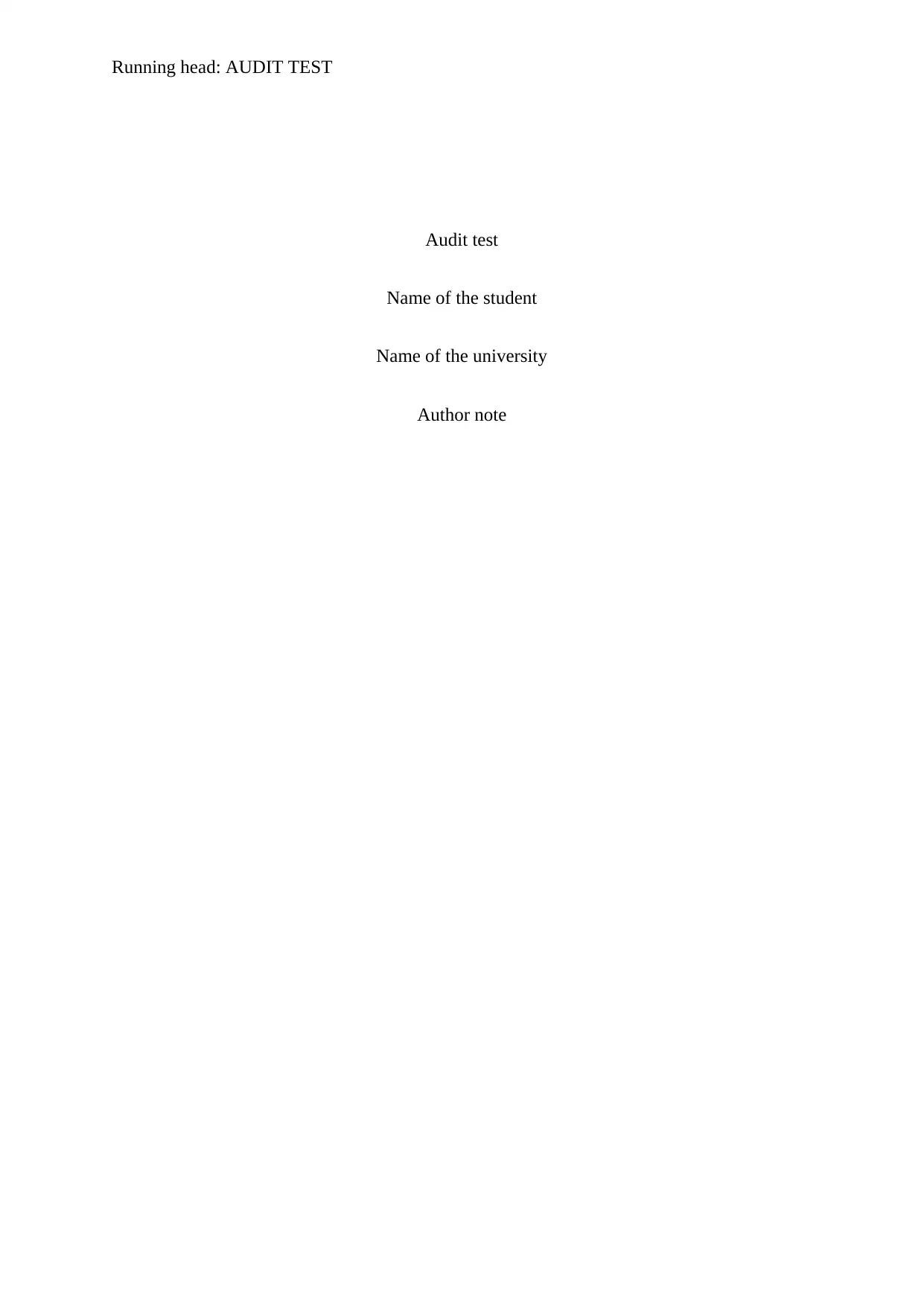
Running head: AUDIT TEST
Audit test
Name of the student
Name of the university
Author note
Audit test
Name of the student
Name of the university
Author note
Paraphrase This Document
Need a fresh take? Get an instant paraphrase of this document with our AI Paraphraser
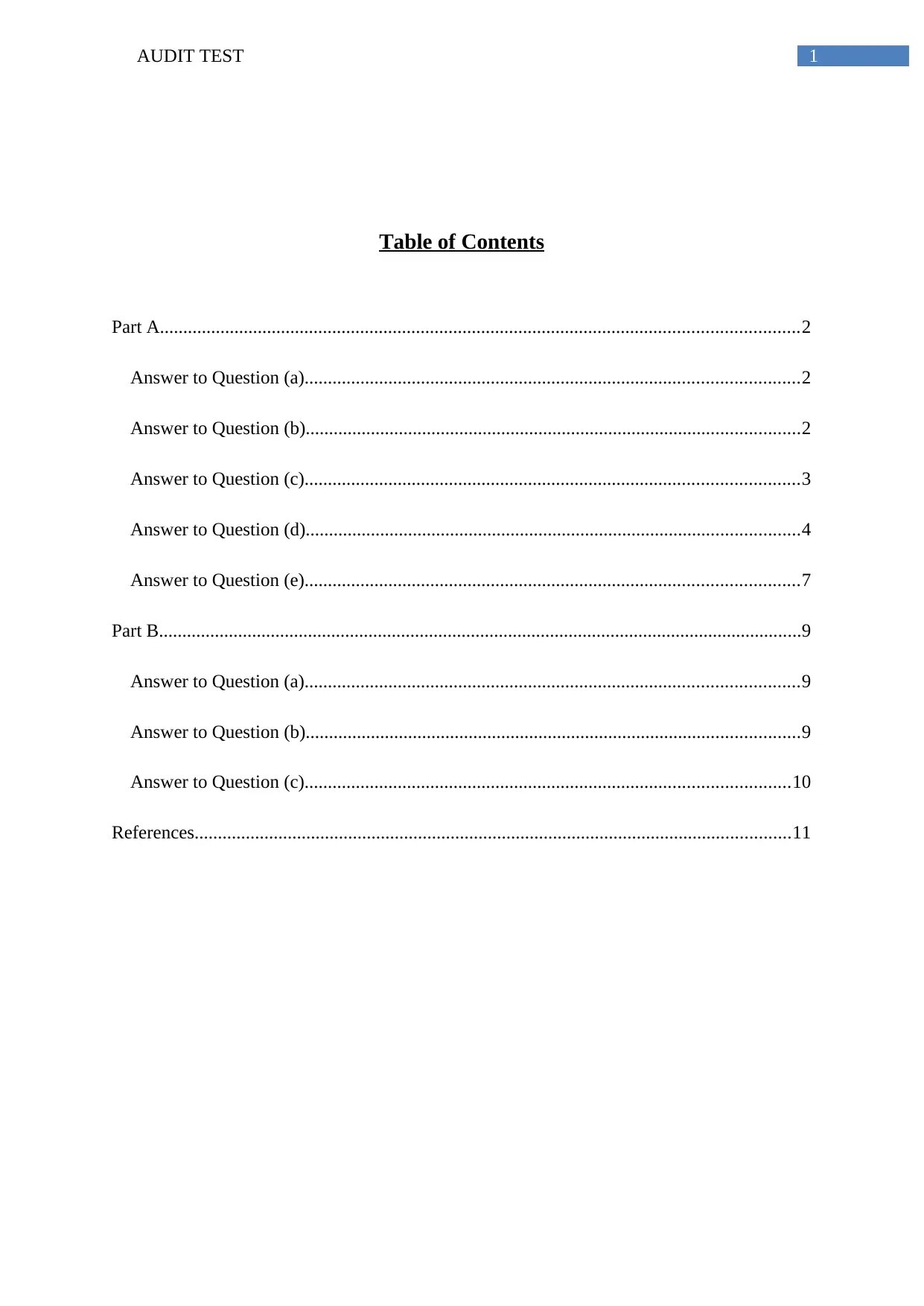
1AUDIT TEST
Table of Contents
Part A.........................................................................................................................................2
Answer to Question (a)..........................................................................................................2
Answer to Question (b)..........................................................................................................2
Answer to Question (c)..........................................................................................................3
Answer to Question (d)..........................................................................................................4
Answer to Question (e)..........................................................................................................7
Part B..........................................................................................................................................9
Answer to Question (a)..........................................................................................................9
Answer to Question (b)..........................................................................................................9
Answer to Question (c)........................................................................................................10
References................................................................................................................................11
Table of Contents
Part A.........................................................................................................................................2
Answer to Question (a)..........................................................................................................2
Answer to Question (b)..........................................................................................................2
Answer to Question (c)..........................................................................................................3
Answer to Question (d)..........................................................................................................4
Answer to Question (e)..........................................................................................................7
Part B..........................................................................................................................................9
Answer to Question (a)..........................................................................................................9
Answer to Question (b)..........................................................................................................9
Answer to Question (c)........................................................................................................10
References................................................................................................................................11
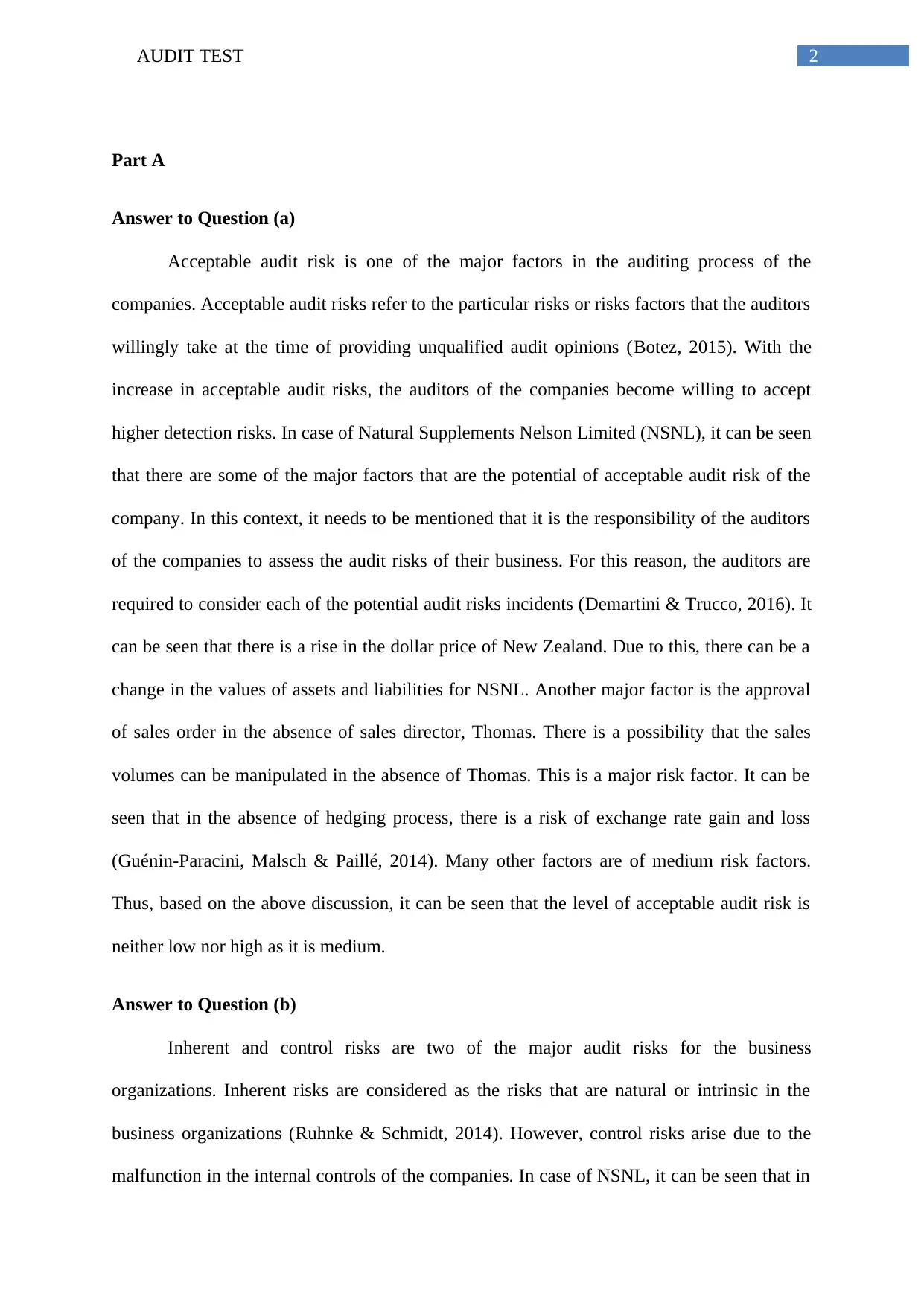
2AUDIT TEST
Part A
Answer to Question (a)
Acceptable audit risk is one of the major factors in the auditing process of the
companies. Acceptable audit risks refer to the particular risks or risks factors that the auditors
willingly take at the time of providing unqualified audit opinions (Botez, 2015). With the
increase in acceptable audit risks, the auditors of the companies become willing to accept
higher detection risks. In case of Natural Supplements Nelson Limited (NSNL), it can be seen
that there are some of the major factors that are the potential of acceptable audit risk of the
company. In this context, it needs to be mentioned that it is the responsibility of the auditors
of the companies to assess the audit risks of their business. For this reason, the auditors are
required to consider each of the potential audit risks incidents (Demartini & Trucco, 2016). It
can be seen that there is a rise in the dollar price of New Zealand. Due to this, there can be a
change in the values of assets and liabilities for NSNL. Another major factor is the approval
of sales order in the absence of sales director, Thomas. There is a possibility that the sales
volumes can be manipulated in the absence of Thomas. This is a major risk factor. It can be
seen that in the absence of hedging process, there is a risk of exchange rate gain and loss
(Guénin-Paracini, Malsch & Paillé, 2014). Many other factors are of medium risk factors.
Thus, based on the above discussion, it can be seen that the level of acceptable audit risk is
neither low nor high as it is medium.
Answer to Question (b)
Inherent and control risks are two of the major audit risks for the business
organizations. Inherent risks are considered as the risks that are natural or intrinsic in the
business organizations (Ruhnke & Schmidt, 2014). However, control risks arise due to the
malfunction in the internal controls of the companies. In case of NSNL, it can be seen that in
Part A
Answer to Question (a)
Acceptable audit risk is one of the major factors in the auditing process of the
companies. Acceptable audit risks refer to the particular risks or risks factors that the auditors
willingly take at the time of providing unqualified audit opinions (Botez, 2015). With the
increase in acceptable audit risks, the auditors of the companies become willing to accept
higher detection risks. In case of Natural Supplements Nelson Limited (NSNL), it can be seen
that there are some of the major factors that are the potential of acceptable audit risk of the
company. In this context, it needs to be mentioned that it is the responsibility of the auditors
of the companies to assess the audit risks of their business. For this reason, the auditors are
required to consider each of the potential audit risks incidents (Demartini & Trucco, 2016). It
can be seen that there is a rise in the dollar price of New Zealand. Due to this, there can be a
change in the values of assets and liabilities for NSNL. Another major factor is the approval
of sales order in the absence of sales director, Thomas. There is a possibility that the sales
volumes can be manipulated in the absence of Thomas. This is a major risk factor. It can be
seen that in the absence of hedging process, there is a risk of exchange rate gain and loss
(Guénin-Paracini, Malsch & Paillé, 2014). Many other factors are of medium risk factors.
Thus, based on the above discussion, it can be seen that the level of acceptable audit risk is
neither low nor high as it is medium.
Answer to Question (b)
Inherent and control risks are two of the major audit risks for the business
organizations. Inherent risks are considered as the risks that are natural or intrinsic in the
business organizations (Ruhnke & Schmidt, 2014). However, control risks arise due to the
malfunction in the internal controls of the companies. In case of NSNL, it can be seen that in
⊘ This is a preview!⊘
Do you want full access?
Subscribe today to unlock all pages.

Trusted by 1+ million students worldwide
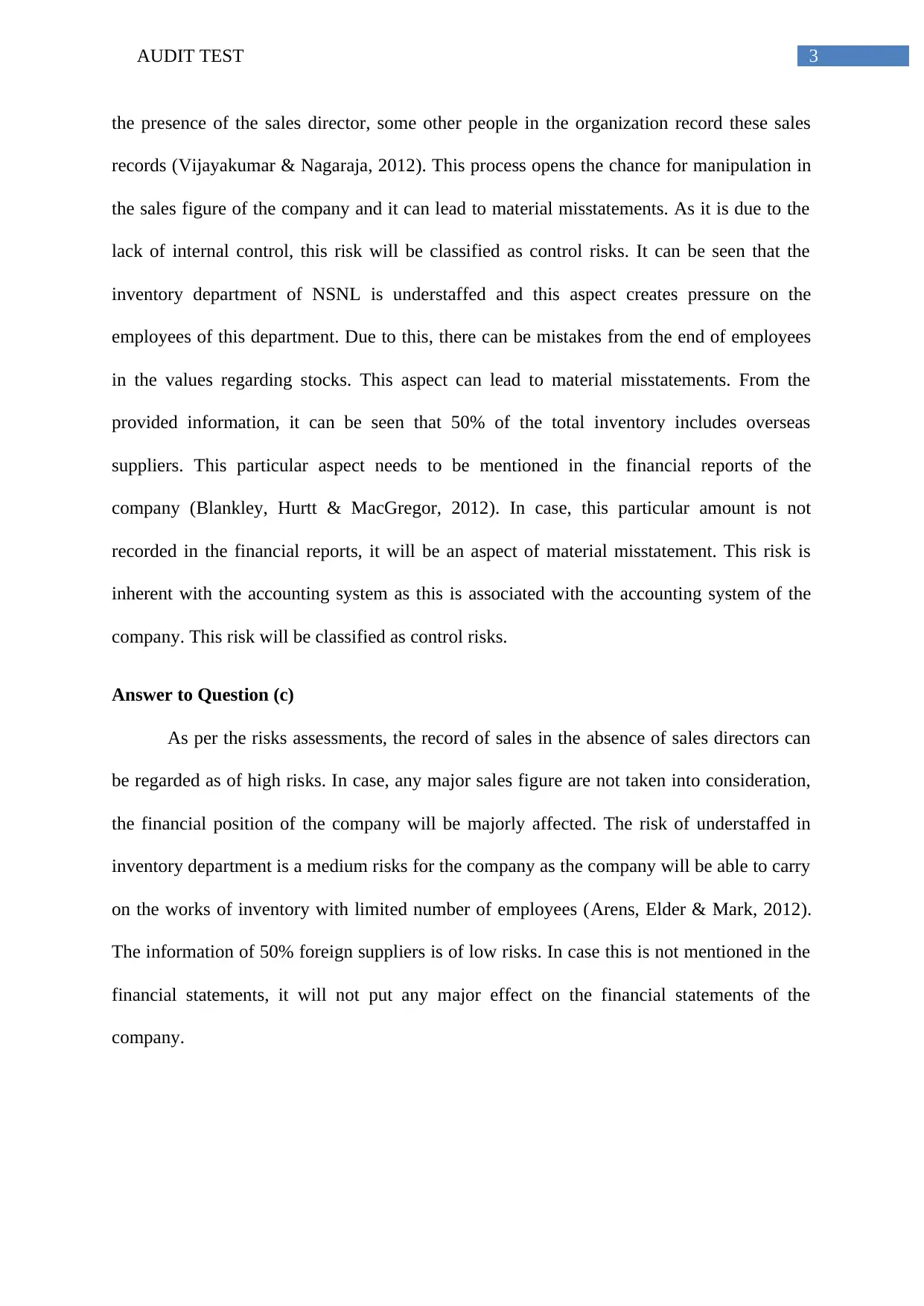
3AUDIT TEST
the presence of the sales director, some other people in the organization record these sales
records (Vijayakumar & Nagaraja, 2012). This process opens the chance for manipulation in
the sales figure of the company and it can lead to material misstatements. As it is due to the
lack of internal control, this risk will be classified as control risks. It can be seen that the
inventory department of NSNL is understaffed and this aspect creates pressure on the
employees of this department. Due to this, there can be mistakes from the end of employees
in the values regarding stocks. This aspect can lead to material misstatements. From the
provided information, it can be seen that 50% of the total inventory includes overseas
suppliers. This particular aspect needs to be mentioned in the financial reports of the
company (Blankley, Hurtt & MacGregor, 2012). In case, this particular amount is not
recorded in the financial reports, it will be an aspect of material misstatement. This risk is
inherent with the accounting system as this is associated with the accounting system of the
company. This risk will be classified as control risks.
Answer to Question (c)
As per the risks assessments, the record of sales in the absence of sales directors can
be regarded as of high risks. In case, any major sales figure are not taken into consideration,
the financial position of the company will be majorly affected. The risk of understaffed in
inventory department is a medium risks for the company as the company will be able to carry
on the works of inventory with limited number of employees (Arens, Elder & Mark, 2012).
The information of 50% foreign suppliers is of low risks. In case this is not mentioned in the
financial statements, it will not put any major effect on the financial statements of the
company.
the presence of the sales director, some other people in the organization record these sales
records (Vijayakumar & Nagaraja, 2012). This process opens the chance for manipulation in
the sales figure of the company and it can lead to material misstatements. As it is due to the
lack of internal control, this risk will be classified as control risks. It can be seen that the
inventory department of NSNL is understaffed and this aspect creates pressure on the
employees of this department. Due to this, there can be mistakes from the end of employees
in the values regarding stocks. This aspect can lead to material misstatements. From the
provided information, it can be seen that 50% of the total inventory includes overseas
suppliers. This particular aspect needs to be mentioned in the financial reports of the
company (Blankley, Hurtt & MacGregor, 2012). In case, this particular amount is not
recorded in the financial reports, it will be an aspect of material misstatement. This risk is
inherent with the accounting system as this is associated with the accounting system of the
company. This risk will be classified as control risks.
Answer to Question (c)
As per the risks assessments, the record of sales in the absence of sales directors can
be regarded as of high risks. In case, any major sales figure are not taken into consideration,
the financial position of the company will be majorly affected. The risk of understaffed in
inventory department is a medium risks for the company as the company will be able to carry
on the works of inventory with limited number of employees (Arens, Elder & Mark, 2012).
The information of 50% foreign suppliers is of low risks. In case this is not mentioned in the
financial statements, it will not put any major effect on the financial statements of the
company.
Paraphrase This Document
Need a fresh take? Get an instant paraphrase of this document with our AI Paraphraser
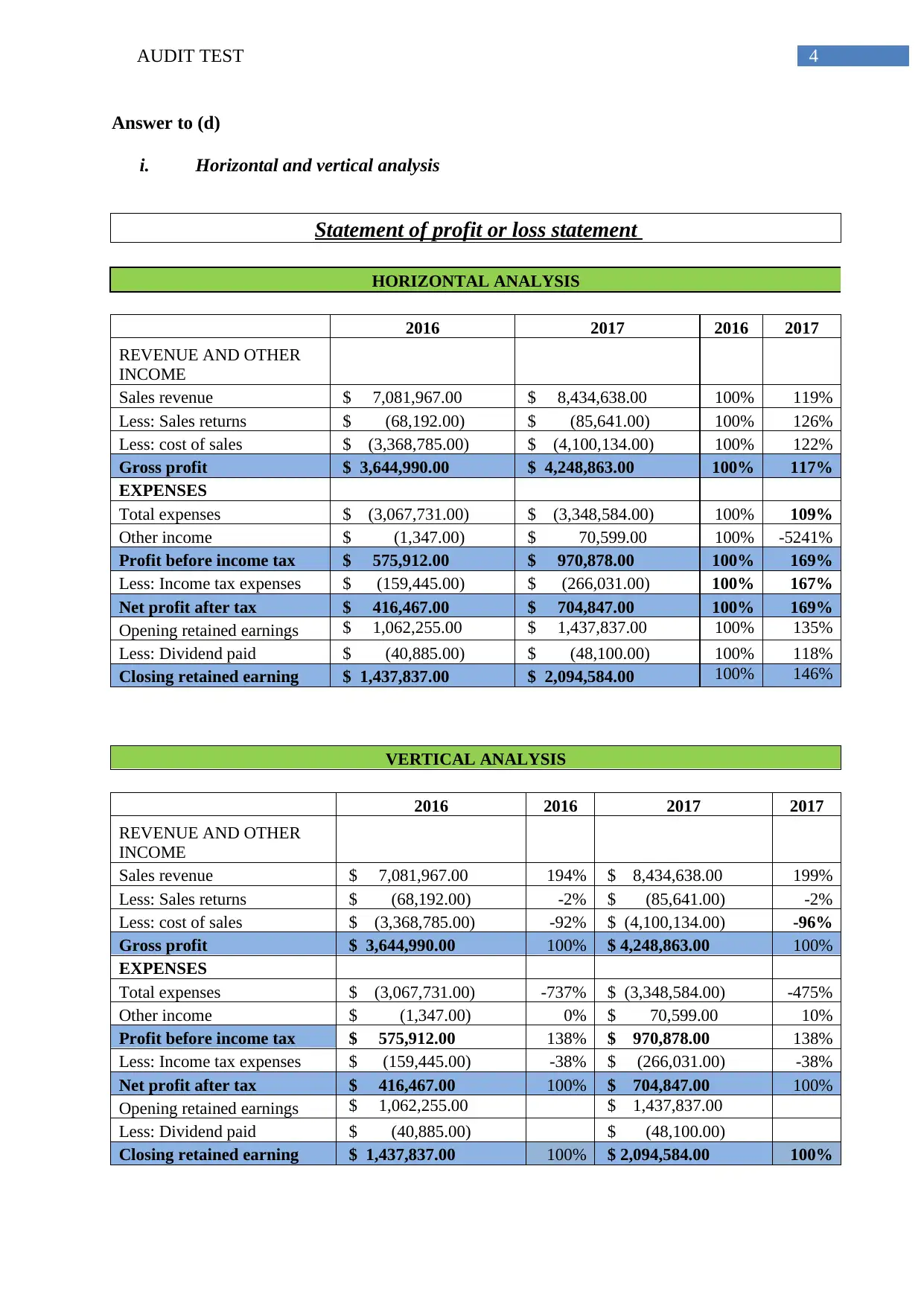
4AUDIT TEST
Answer to (d)
i. Horizontal and vertical analysis
Statement of profit or loss statement
HORIZONTAL ANALYSIS
2016 2017 2016 2017
REVENUE AND OTHER
INCOME
Sales revenue $ 7,081,967.00 $ 8,434,638.00 100% 119%
Less: Sales returns $ (68,192.00) $ (85,641.00) 100% 126%
Less: cost of sales $ (3,368,785.00) $ (4,100,134.00) 100% 122%
Gross profit $ 3,644,990.00 $ 4,248,863.00 100% 117%
EXPENSES
Total expenses $ (3,067,731.00) $ (3,348,584.00) 100% 109%
Other income $ (1,347.00) $ 70,599.00 100% -5241%
Profit before income tax $ 575,912.00 $ 970,878.00 100% 169%
Less: Income tax expenses $ (159,445.00) $ (266,031.00) 100% 167%
Net profit after tax $ 416,467.00 $ 704,847.00 100% 169%
Opening retained earnings $ 1,062,255.00 $ 1,437,837.00 100% 135%
Less: Dividend paid $ (40,885.00) $ (48,100.00) 100% 118%
Closing retained earning $ 1,437,837.00 $ 2,094,584.00 100% 146%
VERTICAL ANALYSIS
2016 2016 2017 2017
REVENUE AND OTHER
INCOME
Sales revenue $ 7,081,967.00 194% $ 8,434,638.00 199%
Less: Sales returns $ (68,192.00) -2% $ (85,641.00) -2%
Less: cost of sales $ (3,368,785.00) -92% $ (4,100,134.00) -96%
Gross profit $ 3,644,990.00 100% $ 4,248,863.00 100%
EXPENSES
Total expenses $ (3,067,731.00) -737% $ (3,348,584.00) -475%
Other income $ (1,347.00) 0% $ 70,599.00 10%
Profit before income tax $ 575,912.00 138% $ 970,878.00 138%
Less: Income tax expenses $ (159,445.00) -38% $ (266,031.00) -38%
Net profit after tax $ 416,467.00 100% $ 704,847.00 100%
Opening retained earnings $ 1,062,255.00 $ 1,437,837.00
Less: Dividend paid $ (40,885.00) $ (48,100.00)
Closing retained earning $ 1,437,837.00 100% $ 2,094,584.00 100%
Answer to (d)
i. Horizontal and vertical analysis
Statement of profit or loss statement
HORIZONTAL ANALYSIS
2016 2017 2016 2017
REVENUE AND OTHER
INCOME
Sales revenue $ 7,081,967.00 $ 8,434,638.00 100% 119%
Less: Sales returns $ (68,192.00) $ (85,641.00) 100% 126%
Less: cost of sales $ (3,368,785.00) $ (4,100,134.00) 100% 122%
Gross profit $ 3,644,990.00 $ 4,248,863.00 100% 117%
EXPENSES
Total expenses $ (3,067,731.00) $ (3,348,584.00) 100% 109%
Other income $ (1,347.00) $ 70,599.00 100% -5241%
Profit before income tax $ 575,912.00 $ 970,878.00 100% 169%
Less: Income tax expenses $ (159,445.00) $ (266,031.00) 100% 167%
Net profit after tax $ 416,467.00 $ 704,847.00 100% 169%
Opening retained earnings $ 1,062,255.00 $ 1,437,837.00 100% 135%
Less: Dividend paid $ (40,885.00) $ (48,100.00) 100% 118%
Closing retained earning $ 1,437,837.00 $ 2,094,584.00 100% 146%
VERTICAL ANALYSIS
2016 2016 2017 2017
REVENUE AND OTHER
INCOME
Sales revenue $ 7,081,967.00 194% $ 8,434,638.00 199%
Less: Sales returns $ (68,192.00) -2% $ (85,641.00) -2%
Less: cost of sales $ (3,368,785.00) -92% $ (4,100,134.00) -96%
Gross profit $ 3,644,990.00 100% $ 4,248,863.00 100%
EXPENSES
Total expenses $ (3,067,731.00) -737% $ (3,348,584.00) -475%
Other income $ (1,347.00) 0% $ 70,599.00 10%
Profit before income tax $ 575,912.00 138% $ 970,878.00 138%
Less: Income tax expenses $ (159,445.00) -38% $ (266,031.00) -38%
Net profit after tax $ 416,467.00 100% $ 704,847.00 100%
Opening retained earnings $ 1,062,255.00 $ 1,437,837.00
Less: Dividend paid $ (40,885.00) $ (48,100.00)
Closing retained earning $ 1,437,837.00 100% $ 2,094,584.00 100%
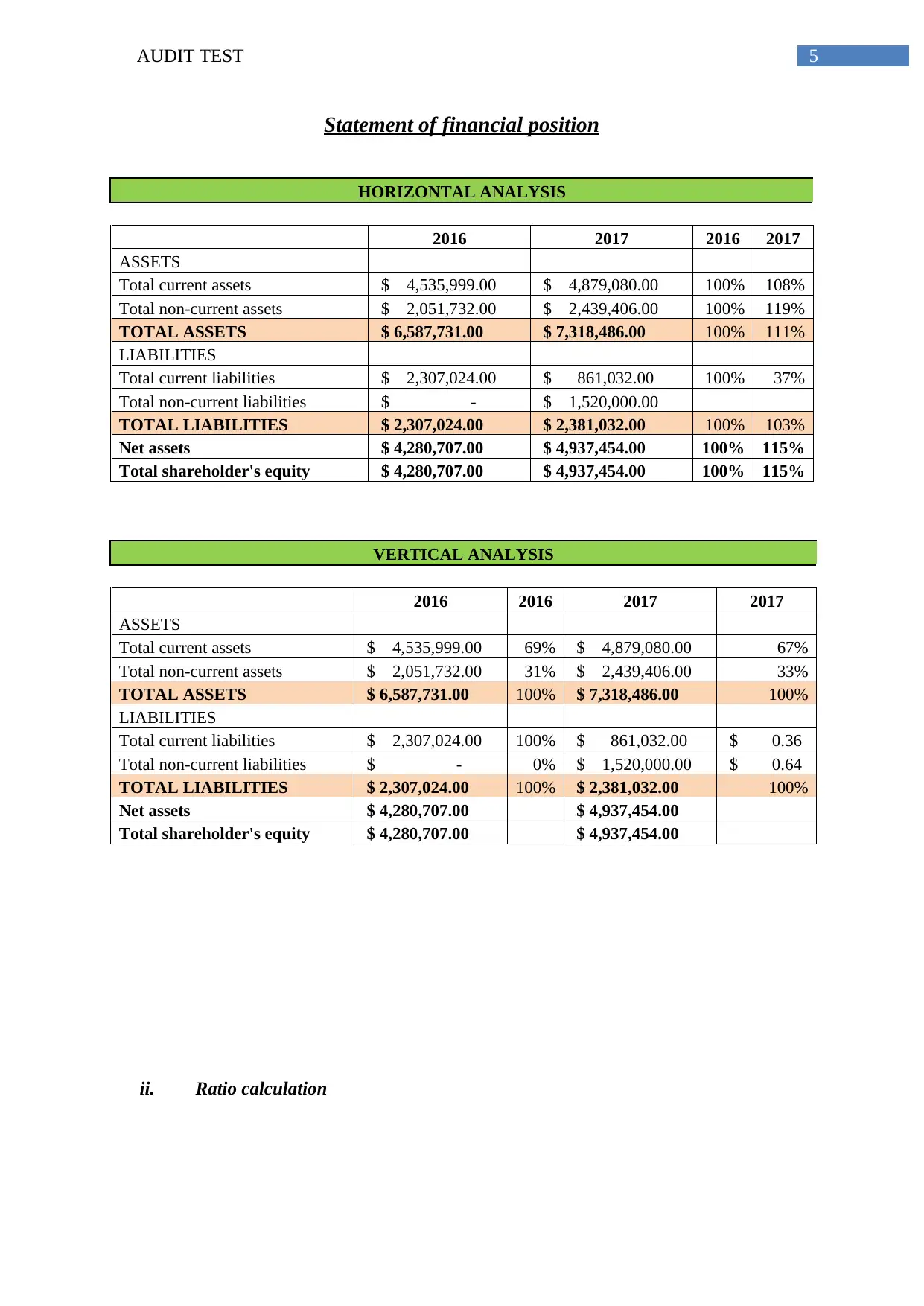
5AUDIT TEST
Statement of financial position
HORIZONTAL ANALYSIS
2016 2017 2016 2017
ASSETS
Total current assets $ 4,535,999.00 $ 4,879,080.00 100% 108%
Total non-current assets $ 2,051,732.00 $ 2,439,406.00 100% 119%
TOTAL ASSETS $ 6,587,731.00 $ 7,318,486.00 100% 111%
LIABILITIES
Total current liabilities $ 2,307,024.00 $ 861,032.00 100% 37%
Total non-current liabilities $ - $ 1,520,000.00
TOTAL LIABILITIES $ 2,307,024.00 $ 2,381,032.00 100% 103%
Net assets $ 4,280,707.00 $ 4,937,454.00 100% 115%
Total shareholder's equity $ 4,280,707.00 $ 4,937,454.00 100% 115%
VERTICAL ANALYSIS
2016 2016 2017 2017
ASSETS
Total current assets $ 4,535,999.00 69% $ 4,879,080.00 67%
Total non-current assets $ 2,051,732.00 31% $ 2,439,406.00 33%
TOTAL ASSETS $ 6,587,731.00 100% $ 7,318,486.00 100%
LIABILITIES
Total current liabilities $ 2,307,024.00 100% $ 861,032.00 $ 0.36
Total non-current liabilities $ - 0% $ 1,520,000.00 $ 0.64
TOTAL LIABILITIES $ 2,307,024.00 100% $ 2,381,032.00 100%
Net assets $ 4,280,707.00 $ 4,937,454.00
Total shareholder's equity $ 4,280,707.00 $ 4,937,454.00
ii. Ratio calculation
Statement of financial position
HORIZONTAL ANALYSIS
2016 2017 2016 2017
ASSETS
Total current assets $ 4,535,999.00 $ 4,879,080.00 100% 108%
Total non-current assets $ 2,051,732.00 $ 2,439,406.00 100% 119%
TOTAL ASSETS $ 6,587,731.00 $ 7,318,486.00 100% 111%
LIABILITIES
Total current liabilities $ 2,307,024.00 $ 861,032.00 100% 37%
Total non-current liabilities $ - $ 1,520,000.00
TOTAL LIABILITIES $ 2,307,024.00 $ 2,381,032.00 100% 103%
Net assets $ 4,280,707.00 $ 4,937,454.00 100% 115%
Total shareholder's equity $ 4,280,707.00 $ 4,937,454.00 100% 115%
VERTICAL ANALYSIS
2016 2016 2017 2017
ASSETS
Total current assets $ 4,535,999.00 69% $ 4,879,080.00 67%
Total non-current assets $ 2,051,732.00 31% $ 2,439,406.00 33%
TOTAL ASSETS $ 6,587,731.00 100% $ 7,318,486.00 100%
LIABILITIES
Total current liabilities $ 2,307,024.00 100% $ 861,032.00 $ 0.36
Total non-current liabilities $ - 0% $ 1,520,000.00 $ 0.64
TOTAL LIABILITIES $ 2,307,024.00 100% $ 2,381,032.00 100%
Net assets $ 4,280,707.00 $ 4,937,454.00
Total shareholder's equity $ 4,280,707.00 $ 4,937,454.00
ii. Ratio calculation
⊘ This is a preview!⊘
Do you want full access?
Subscribe today to unlock all pages.

Trusted by 1+ million students worldwide
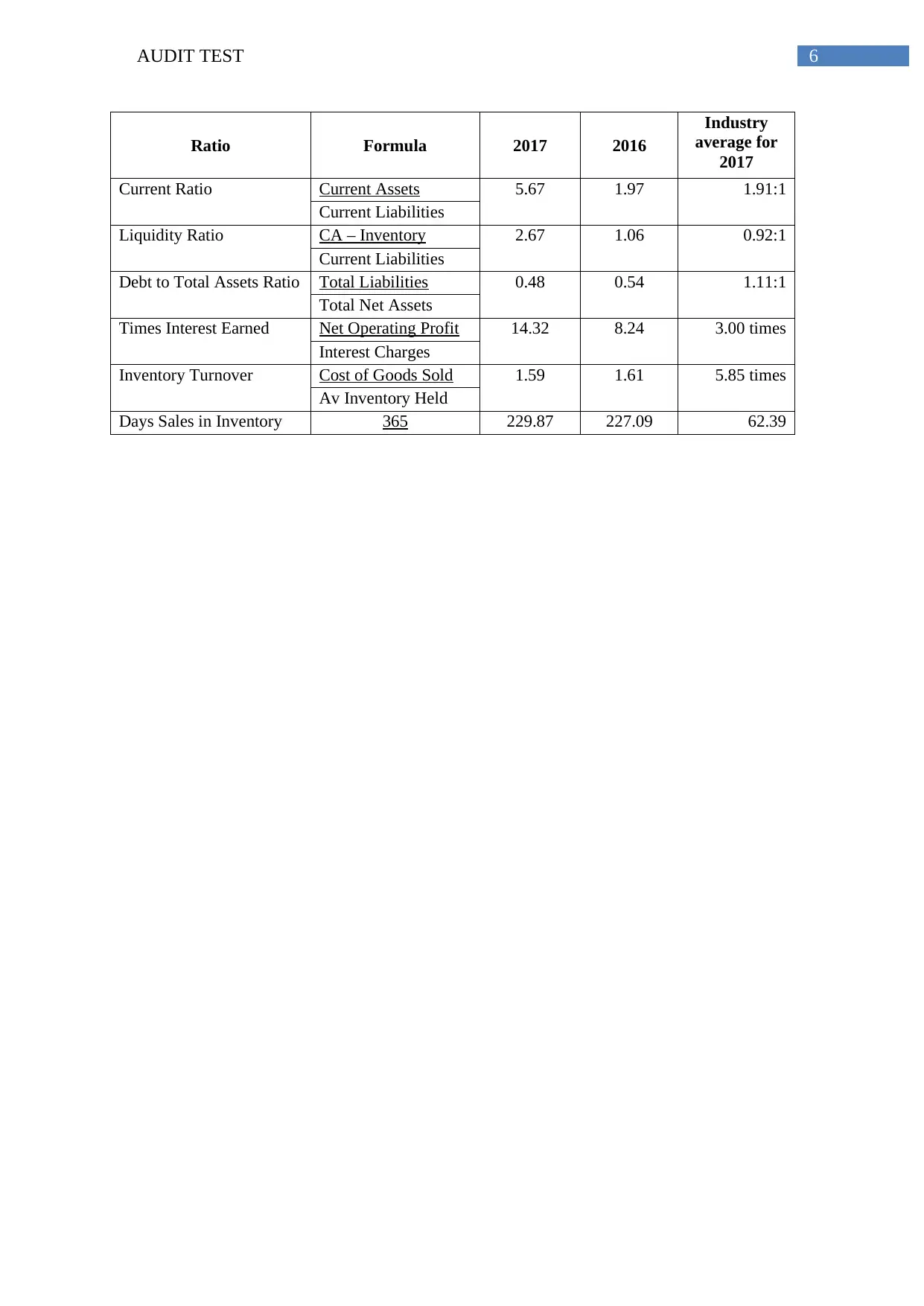
6AUDIT TEST
Ratio Formula 2017 2016
Industry
average for
2017
Current Ratio Current Assets 5.67 1.97 1.91:1
Current Liabilities
Liquidity Ratio CA – Inventory 2.67 1.06 0.92:1
Current Liabilities
Debt to Total Assets Ratio Total Liabilities 0.48 0.54 1.11:1
Total Net Assets
Times Interest Earned Net Operating Profit 14.32 8.24 3.00 times
Interest Charges
Inventory Turnover Cost of Goods Sold 1.59 1.61 5.85 times
Av Inventory Held
Days Sales in Inventory
(days)
365 229.87 227.09 62.39
Ratio Formula 2017 2016
Industry
average for
2017
Current Ratio Current Assets 5.67 1.97 1.91:1
Current Liabilities
Liquidity Ratio CA – Inventory 2.67 1.06 0.92:1
Current Liabilities
Debt to Total Assets Ratio Total Liabilities 0.48 0.54 1.11:1
Total Net Assets
Times Interest Earned Net Operating Profit 14.32 8.24 3.00 times
Interest Charges
Inventory Turnover Cost of Goods Sold 1.59 1.61 5.85 times
Av Inventory Held
Days Sales in Inventory
(days)
365 229.87 227.09 62.39
Paraphrase This Document
Need a fresh take? Get an instant paraphrase of this document with our AI Paraphraser
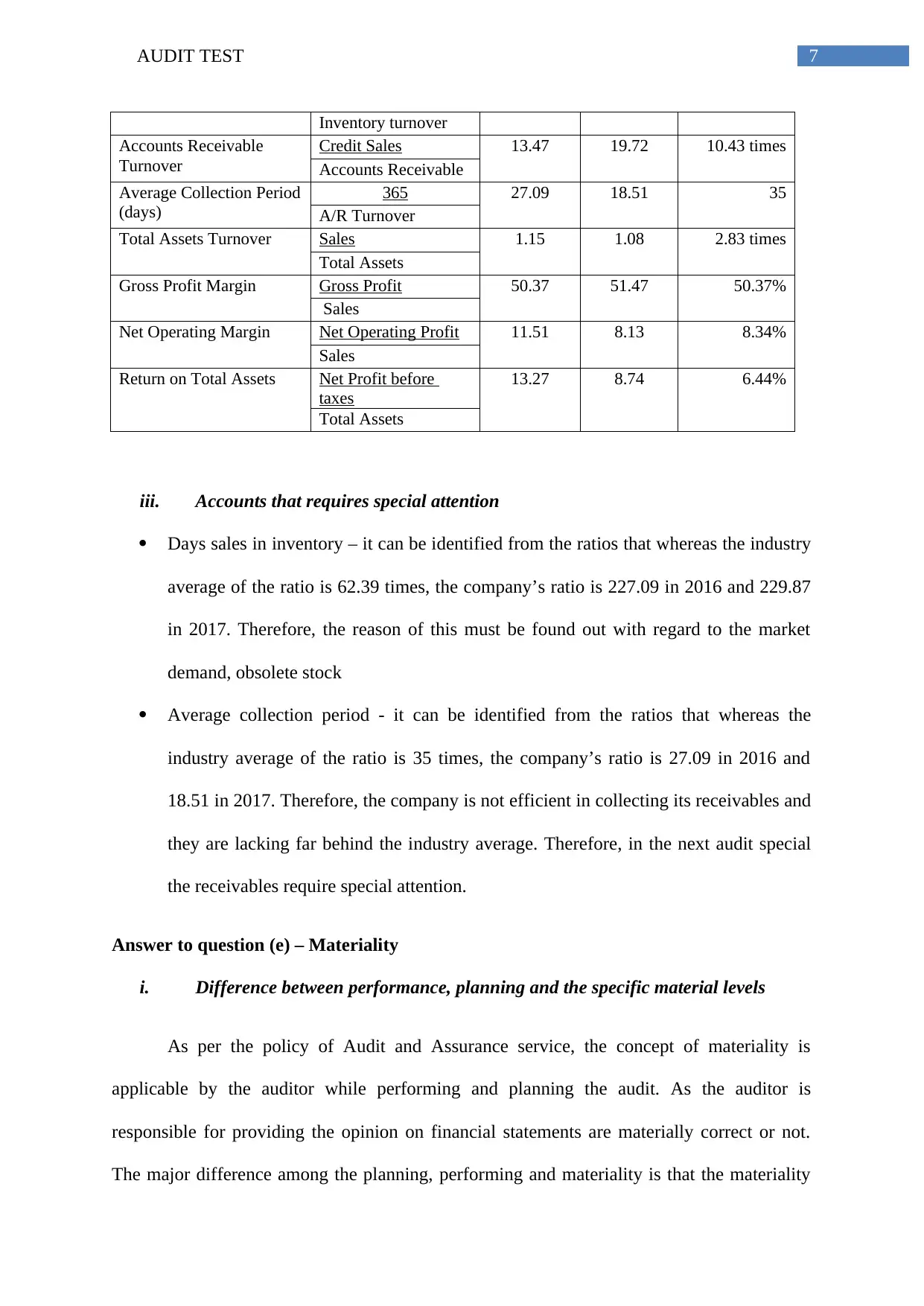
7AUDIT TEST
Inventory turnover
Accounts Receivable
Turnover
Credit Sales 13.47 19.72 10.43 times
Accounts Receivable
Average Collection Period
(days)
365 27.09 18.51 35
A/R Turnover
Total Assets Turnover Sales 1.15 1.08 2.83 times
Total Assets
Gross Profit Margin Gross Profit 50.37 51.47 50.37%
Sales
Net Operating Margin Net Operating Profit 11.51 8.13 8.34%
Sales
Return on Total Assets Net Profit before
taxes
13.27 8.74 6.44%
Total Assets
iii. Accounts that requires special attention
Days sales in inventory – it can be identified from the ratios that whereas the industry
average of the ratio is 62.39 times, the company’s ratio is 227.09 in 2016 and 229.87
in 2017. Therefore, the reason of this must be found out with regard to the market
demand, obsolete stock
Average collection period - it can be identified from the ratios that whereas the
industry average of the ratio is 35 times, the company’s ratio is 27.09 in 2016 and
18.51 in 2017. Therefore, the company is not efficient in collecting its receivables and
they are lacking far behind the industry average. Therefore, in the next audit special
the receivables require special attention.
Answer to question (e) – Materiality
i. Difference between performance, planning and the specific material levels
As per the policy of Audit and Assurance service, the concept of materiality is
applicable by the auditor while performing and planning the audit. As the auditor is
responsible for providing the opinion on financial statements are materially correct or not.
The major difference among the planning, performing and materiality is that the materiality
Inventory turnover
Accounts Receivable
Turnover
Credit Sales 13.47 19.72 10.43 times
Accounts Receivable
Average Collection Period
(days)
365 27.09 18.51 35
A/R Turnover
Total Assets Turnover Sales 1.15 1.08 2.83 times
Total Assets
Gross Profit Margin Gross Profit 50.37 51.47 50.37%
Sales
Net Operating Margin Net Operating Profit 11.51 8.13 8.34%
Sales
Return on Total Assets Net Profit before
taxes
13.27 8.74 6.44%
Total Assets
iii. Accounts that requires special attention
Days sales in inventory – it can be identified from the ratios that whereas the industry
average of the ratio is 62.39 times, the company’s ratio is 227.09 in 2016 and 229.87
in 2017. Therefore, the reason of this must be found out with regard to the market
demand, obsolete stock
Average collection period - it can be identified from the ratios that whereas the
industry average of the ratio is 35 times, the company’s ratio is 27.09 in 2016 and
18.51 in 2017. Therefore, the company is not efficient in collecting its receivables and
they are lacking far behind the industry average. Therefore, in the next audit special
the receivables require special attention.
Answer to question (e) – Materiality
i. Difference between performance, planning and the specific material levels
As per the policy of Audit and Assurance service, the concept of materiality is
applicable by the auditor while performing and planning the audit. As the auditor is
responsible for providing the opinion on financial statements are materially correct or not.
The major difference among the planning, performing and materiality is that the materiality
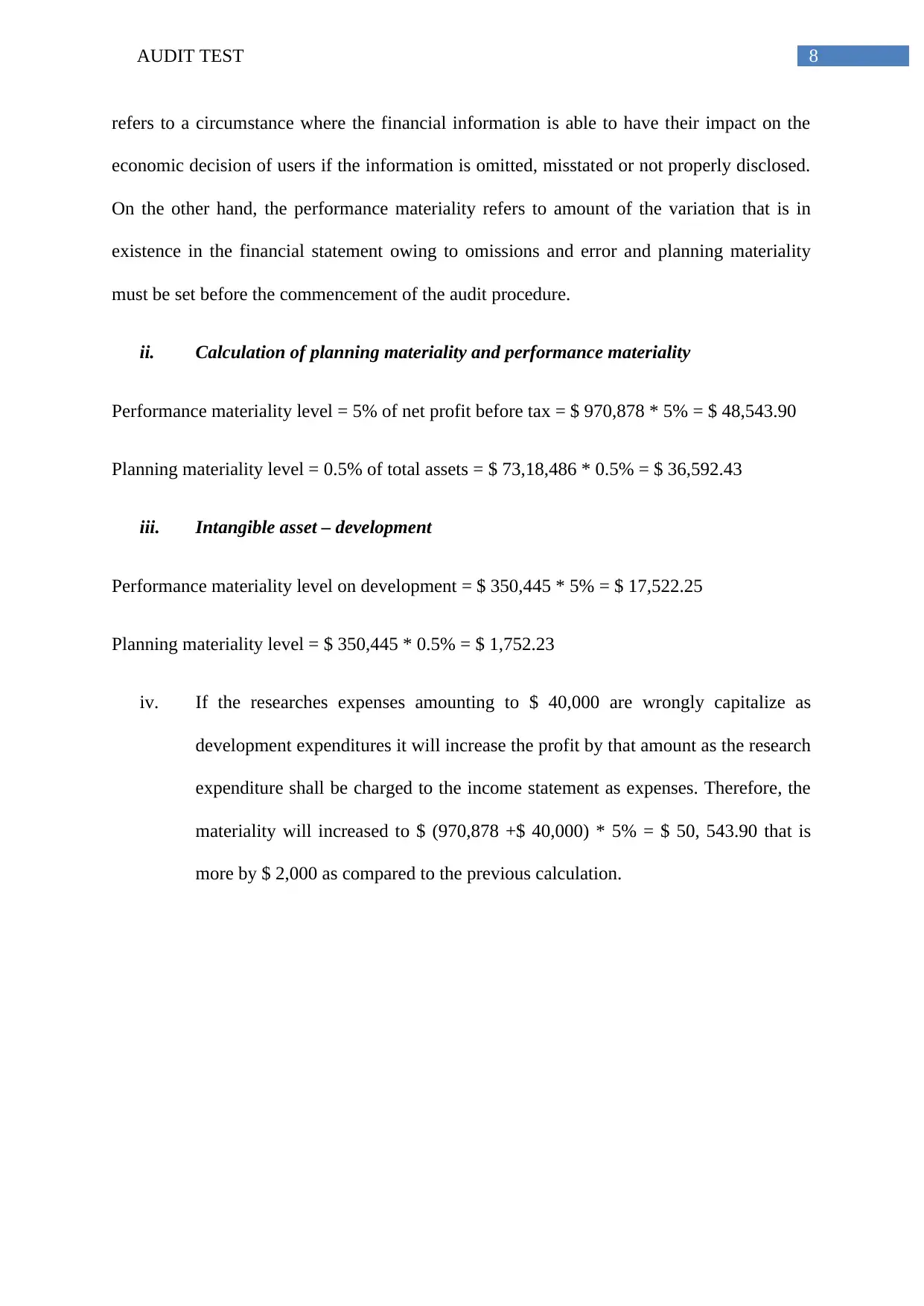
8AUDIT TEST
refers to a circumstance where the financial information is able to have their impact on the
economic decision of users if the information is omitted, misstated or not properly disclosed.
On the other hand, the performance materiality refers to amount of the variation that is in
existence in the financial statement owing to omissions and error and planning materiality
must be set before the commencement of the audit procedure.
ii. Calculation of planning materiality and performance materiality
Performance materiality level = 5% of net profit before tax = $ 970,878 * 5% = $ 48,543.90
Planning materiality level = 0.5% of total assets = $ 73,18,486 * 0.5% = $ 36,592.43
iii. Intangible asset – development
Performance materiality level on development = $ 350,445 * 5% = $ 17,522.25
Planning materiality level = $ 350,445 * 0.5% = $ 1,752.23
iv. If the researches expenses amounting to $ 40,000 are wrongly capitalize as
development expenditures it will increase the profit by that amount as the research
expenditure shall be charged to the income statement as expenses. Therefore, the
materiality will increased to $ (970,878 +$ 40,000) * 5% = $ 50, 543.90 that is
more by $ 2,000 as compared to the previous calculation.
refers to a circumstance where the financial information is able to have their impact on the
economic decision of users if the information is omitted, misstated or not properly disclosed.
On the other hand, the performance materiality refers to amount of the variation that is in
existence in the financial statement owing to omissions and error and planning materiality
must be set before the commencement of the audit procedure.
ii. Calculation of planning materiality and performance materiality
Performance materiality level = 5% of net profit before tax = $ 970,878 * 5% = $ 48,543.90
Planning materiality level = 0.5% of total assets = $ 73,18,486 * 0.5% = $ 36,592.43
iii. Intangible asset – development
Performance materiality level on development = $ 350,445 * 5% = $ 17,522.25
Planning materiality level = $ 350,445 * 0.5% = $ 1,752.23
iv. If the researches expenses amounting to $ 40,000 are wrongly capitalize as
development expenditures it will increase the profit by that amount as the research
expenditure shall be charged to the income statement as expenses. Therefore, the
materiality will increased to $ (970,878 +$ 40,000) * 5% = $ 50, 543.90 that is
more by $ 2,000 as compared to the previous calculation.
⊘ This is a preview!⊘
Do you want full access?
Subscribe today to unlock all pages.

Trusted by 1+ million students worldwide
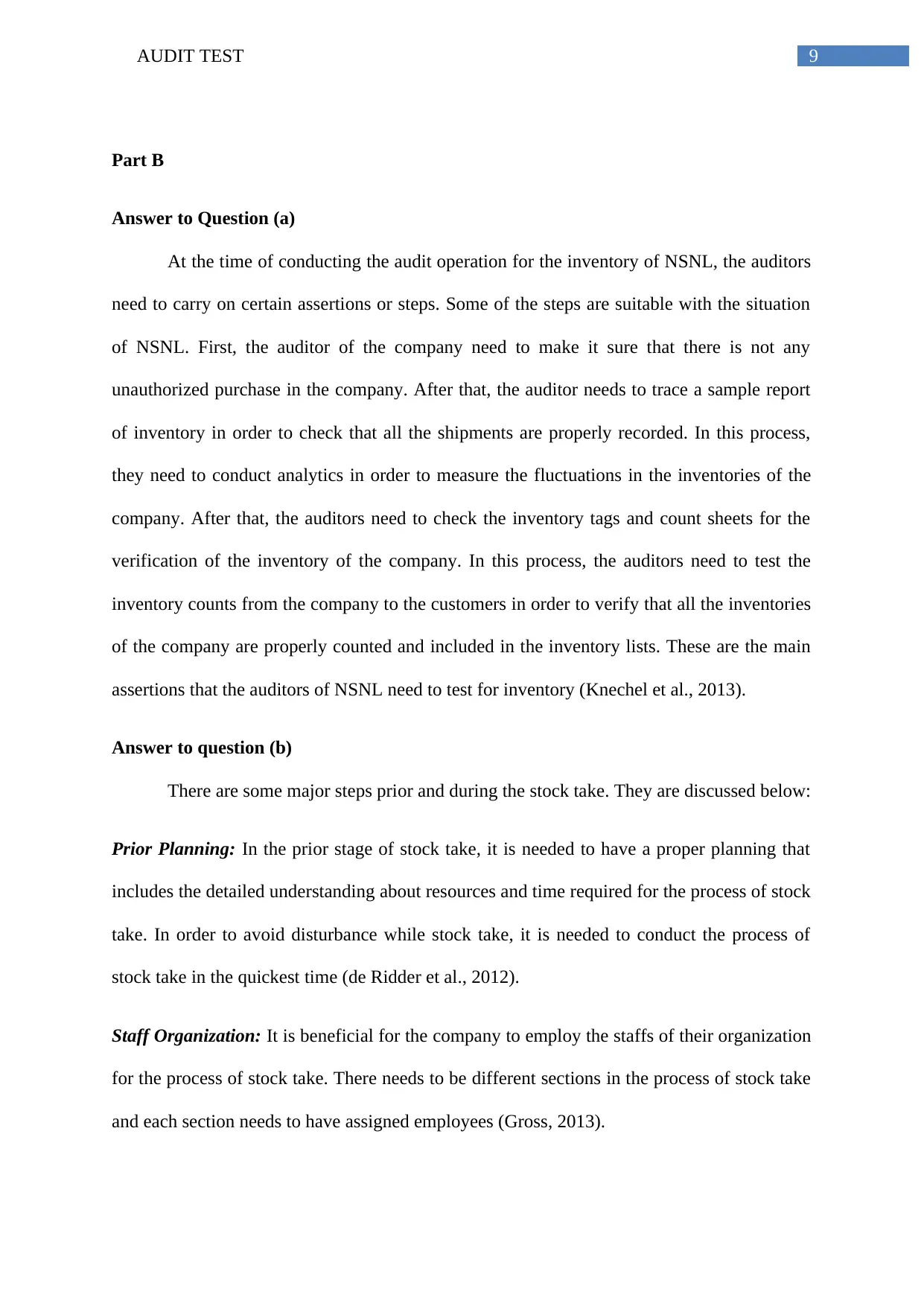
9AUDIT TEST
Part B
Answer to Question (a)
At the time of conducting the audit operation for the inventory of NSNL, the auditors
need to carry on certain assertions or steps. Some of the steps are suitable with the situation
of NSNL. First, the auditor of the company need to make it sure that there is not any
unauthorized purchase in the company. After that, the auditor needs to trace a sample report
of inventory in order to check that all the shipments are properly recorded. In this process,
they need to conduct analytics in order to measure the fluctuations in the inventories of the
company. After that, the auditors need to check the inventory tags and count sheets for the
verification of the inventory of the company. In this process, the auditors need to test the
inventory counts from the company to the customers in order to verify that all the inventories
of the company are properly counted and included in the inventory lists. These are the main
assertions that the auditors of NSNL need to test for inventory (Knechel et al., 2013).
Answer to question (b)
There are some major steps prior and during the stock take. They are discussed below:
Prior Planning: In the prior stage of stock take, it is needed to have a proper planning that
includes the detailed understanding about resources and time required for the process of stock
take. In order to avoid disturbance while stock take, it is needed to conduct the process of
stock take in the quickest time (de Ridder et al., 2012).
Staff Organization: It is beneficial for the company to employ the staffs of their organization
for the process of stock take. There needs to be different sections in the process of stock take
and each section needs to have assigned employees (Gross, 2013).
Part B
Answer to Question (a)
At the time of conducting the audit operation for the inventory of NSNL, the auditors
need to carry on certain assertions or steps. Some of the steps are suitable with the situation
of NSNL. First, the auditor of the company need to make it sure that there is not any
unauthorized purchase in the company. After that, the auditor needs to trace a sample report
of inventory in order to check that all the shipments are properly recorded. In this process,
they need to conduct analytics in order to measure the fluctuations in the inventories of the
company. After that, the auditors need to check the inventory tags and count sheets for the
verification of the inventory of the company. In this process, the auditors need to test the
inventory counts from the company to the customers in order to verify that all the inventories
of the company are properly counted and included in the inventory lists. These are the main
assertions that the auditors of NSNL need to test for inventory (Knechel et al., 2013).
Answer to question (b)
There are some major steps prior and during the stock take. They are discussed below:
Prior Planning: In the prior stage of stock take, it is needed to have a proper planning that
includes the detailed understanding about resources and time required for the process of stock
take. In order to avoid disturbance while stock take, it is needed to conduct the process of
stock take in the quickest time (de Ridder et al., 2012).
Staff Organization: It is beneficial for the company to employ the staffs of their organization
for the process of stock take. There needs to be different sections in the process of stock take
and each section needs to have assigned employees (Gross, 2013).
Paraphrase This Document
Need a fresh take? Get an instant paraphrase of this document with our AI Paraphraser
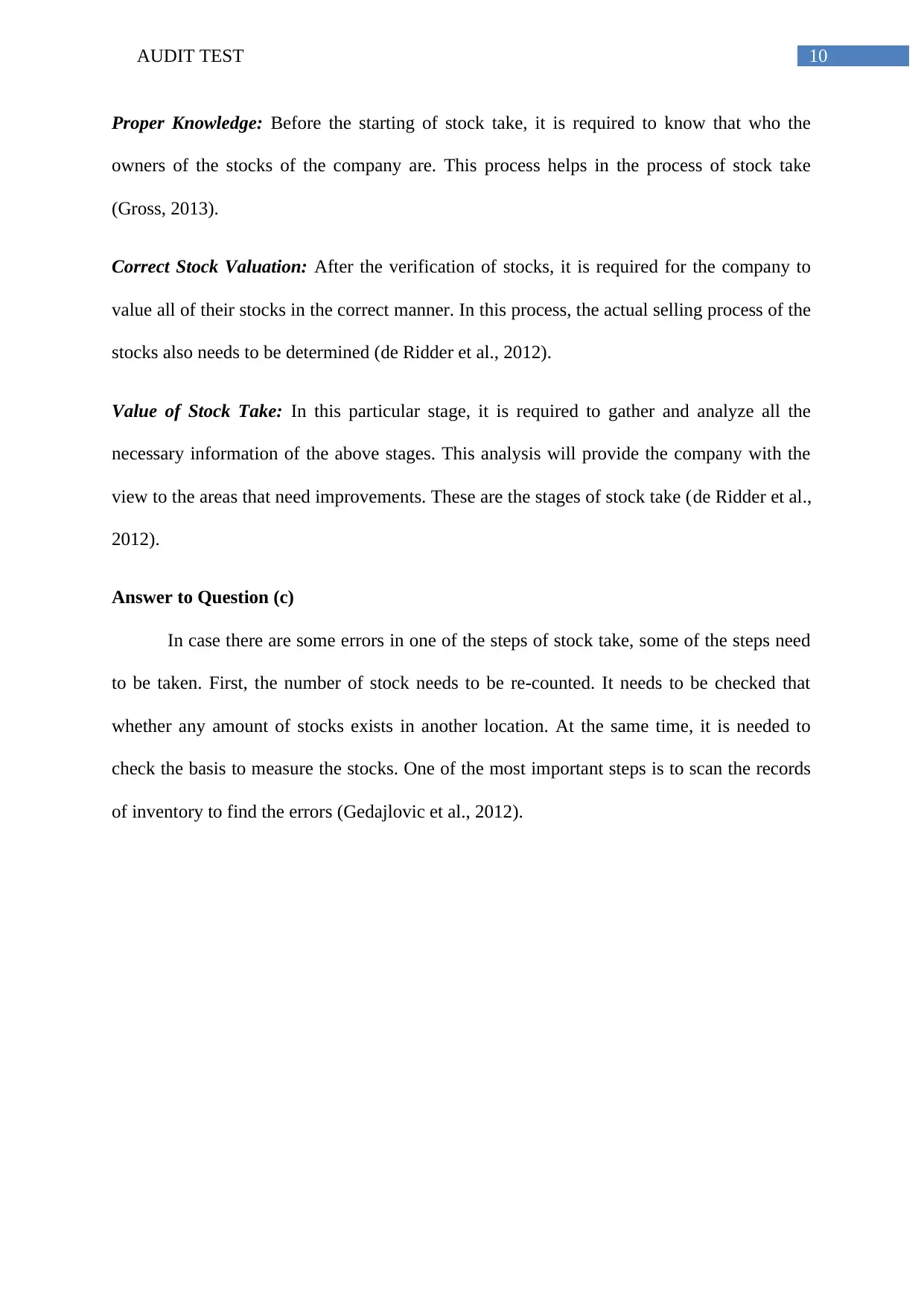
10AUDIT TEST
Proper Knowledge: Before the starting of stock take, it is required to know that who the
owners of the stocks of the company are. This process helps in the process of stock take
(Gross, 2013).
Correct Stock Valuation: After the verification of stocks, it is required for the company to
value all of their stocks in the correct manner. In this process, the actual selling process of the
stocks also needs to be determined (de Ridder et al., 2012).
Value of Stock Take: In this particular stage, it is required to gather and analyze all the
necessary information of the above stages. This analysis will provide the company with the
view to the areas that need improvements. These are the stages of stock take (de Ridder et al.,
2012).
Answer to Question (c)
In case there are some errors in one of the steps of stock take, some of the steps need
to be taken. First, the number of stock needs to be re-counted. It needs to be checked that
whether any amount of stocks exists in another location. At the same time, it is needed to
check the basis to measure the stocks. One of the most important steps is to scan the records
of inventory to find the errors (Gedajlovic et al., 2012).
Proper Knowledge: Before the starting of stock take, it is required to know that who the
owners of the stocks of the company are. This process helps in the process of stock take
(Gross, 2013).
Correct Stock Valuation: After the verification of stocks, it is required for the company to
value all of their stocks in the correct manner. In this process, the actual selling process of the
stocks also needs to be determined (de Ridder et al., 2012).
Value of Stock Take: In this particular stage, it is required to gather and analyze all the
necessary information of the above stages. This analysis will provide the company with the
view to the areas that need improvements. These are the stages of stock take (de Ridder et al.,
2012).
Answer to Question (c)
In case there are some errors in one of the steps of stock take, some of the steps need
to be taken. First, the number of stock needs to be re-counted. It needs to be checked that
whether any amount of stocks exists in another location. At the same time, it is needed to
check the basis to measure the stocks. One of the most important steps is to scan the records
of inventory to find the errors (Gedajlovic et al., 2012).
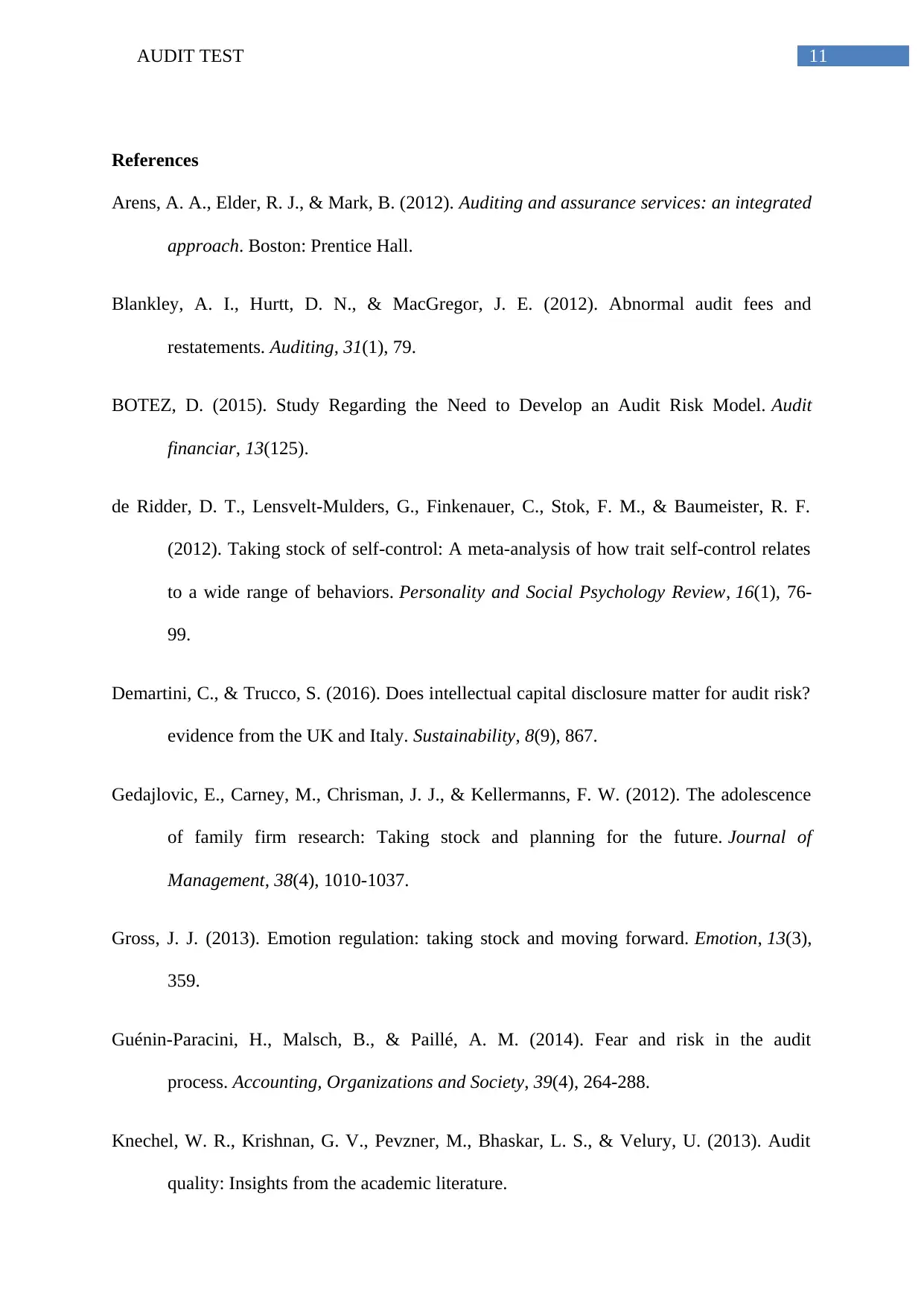
11AUDIT TEST
References
Arens, A. A., Elder, R. J., & Mark, B. (2012). Auditing and assurance services: an integrated
approach. Boston: Prentice Hall.
Blankley, A. I., Hurtt, D. N., & MacGregor, J. E. (2012). Abnormal audit fees and
restatements. Auditing, 31(1), 79.
BOTEZ, D. (2015). Study Regarding the Need to Develop an Audit Risk Model. Audit
financiar, 13(125).
de Ridder, D. T., Lensvelt-Mulders, G., Finkenauer, C., Stok, F. M., & Baumeister, R. F.
(2012). Taking stock of self-control: A meta-analysis of how trait self-control relates
to a wide range of behaviors. Personality and Social Psychology Review, 16(1), 76-
99.
Demartini, C., & Trucco, S. (2016). Does intellectual capital disclosure matter for audit risk?
evidence from the UK and Italy. Sustainability, 8(9), 867.
Gedajlovic, E., Carney, M., Chrisman, J. J., & Kellermanns, F. W. (2012). The adolescence
of family firm research: Taking stock and planning for the future. Journal of
Management, 38(4), 1010-1037.
Gross, J. J. (2013). Emotion regulation: taking stock and moving forward. Emotion, 13(3),
359.
Guénin-Paracini, H., Malsch, B., & Paillé, A. M. (2014). Fear and risk in the audit
process. Accounting, Organizations and Society, 39(4), 264-288.
Knechel, W. R., Krishnan, G. V., Pevzner, M., Bhaskar, L. S., & Velury, U. (2013). Audit
quality: Insights from the academic literature.
References
Arens, A. A., Elder, R. J., & Mark, B. (2012). Auditing and assurance services: an integrated
approach. Boston: Prentice Hall.
Blankley, A. I., Hurtt, D. N., & MacGregor, J. E. (2012). Abnormal audit fees and
restatements. Auditing, 31(1), 79.
BOTEZ, D. (2015). Study Regarding the Need to Develop an Audit Risk Model. Audit
financiar, 13(125).
de Ridder, D. T., Lensvelt-Mulders, G., Finkenauer, C., Stok, F. M., & Baumeister, R. F.
(2012). Taking stock of self-control: A meta-analysis of how trait self-control relates
to a wide range of behaviors. Personality and Social Psychology Review, 16(1), 76-
99.
Demartini, C., & Trucco, S. (2016). Does intellectual capital disclosure matter for audit risk?
evidence from the UK and Italy. Sustainability, 8(9), 867.
Gedajlovic, E., Carney, M., Chrisman, J. J., & Kellermanns, F. W. (2012). The adolescence
of family firm research: Taking stock and planning for the future. Journal of
Management, 38(4), 1010-1037.
Gross, J. J. (2013). Emotion regulation: taking stock and moving forward. Emotion, 13(3),
359.
Guénin-Paracini, H., Malsch, B., & Paillé, A. M. (2014). Fear and risk in the audit
process. Accounting, Organizations and Society, 39(4), 264-288.
Knechel, W. R., Krishnan, G. V., Pevzner, M., Bhaskar, L. S., & Velury, U. (2013). Audit
quality: Insights from the academic literature.
⊘ This is a preview!⊘
Do you want full access?
Subscribe today to unlock all pages.

Trusted by 1+ million students worldwide
1 out of 13
Related Documents
Your All-in-One AI-Powered Toolkit for Academic Success.
+13062052269
info@desklib.com
Available 24*7 on WhatsApp / Email
![[object Object]](/_next/static/media/star-bottom.7253800d.svg)
Unlock your academic potential
Copyright © 2020–2025 A2Z Services. All Rights Reserved. Developed and managed by ZUCOL.




